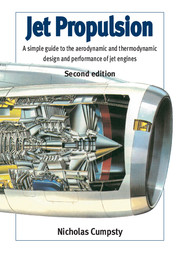 Jet Propulsion
Jet Propulsion Book contents
- Frontmatter
- Contents
- Preface
- Glossary
- Nomenclature
- Part 1 Design of Engines for a New 600-seat Aircraft
- Part 2 Engine Component Characteristics and Engine Matching
- Part 3 Design of Engines for a New Fighter Aircraft
- Part 4 Return to the Civil Transport Engine
- 19 A Return to the Civil Transport Engine
- 20 To Conclude
- Appendix: Noise and its Regulation
- Bibliography
- References
- Index
- Design sheets for New Large Civil Aircraft and New Fighter Aircraft
20 - To Conclude
from Part 4 - Return to the Civil Transport Engine
- Frontmatter
- Contents
- Preface
- Glossary
- Nomenclature
- Part 1 Design of Engines for a New 600-seat Aircraft
- Part 2 Engine Component Characteristics and Engine Matching
- Part 3 Design of Engines for a New Fighter Aircraft
- Part 4 Return to the Civil Transport Engine
- 19 A Return to the Civil Transport Engine
- 20 To Conclude
- Appendix: Noise and its Regulation
- Bibliography
- References
- Index
- Design sheets for New Large Civil Aircraft and New Fighter Aircraft
Summary
INTRODUCTION
This chapter returns to some general issues related to both civil and military engines. These are topics which can more satisfactorily be addressed with the background of earlier chapters.
CHOICE OF NUMBER OF ENGINES FOR CIVIL AIRCRAFT
The design for the New Large Aircraft assumed that there would be four engines and indeed the Airbus A380 does have four engines. When the first jet aircraft were beginning to fly across the Atlantic ocean four engines were necessary to cope with the possibility of loss in thrust in one engine at take off; to have had to accommodate loss of one engine with fewer than four engines would have involved carrying a lot of unnecessary engine weight (and available thrust) during cruise. Even when the Boeing 747 entered service around 1970, four engines were considered optimum for a transatlantic flight; the large twin-engine aircraft introduced by Airbus, the A300, seemed suited only to shorter routes. By the 1990s the most widely used aircraft on the transatlantic route were twin-engine aircraft, such as the Boeing 767 or Airbus 300, providing non-stop flights from, for example, London to Los Angeles (4700 nautical miles). The more recent twin, the Boeing 777, is used mainly for flights under 5000 nautical miles but the newer long-range version will have a range of 8810 nautical miles. It is reasonable to ask what has changed to make it possible and second what has made it attractive to use twin-engine aircraft on such long routes?
- Type
- Chapter
- Information
- Jet PropulsionA Simple Guide to the Aerodynamic and Thermodynamic Design and Performance of Jet Engines, pp. 283 - 288Publisher: Cambridge University PressPrint publication year: 2003


